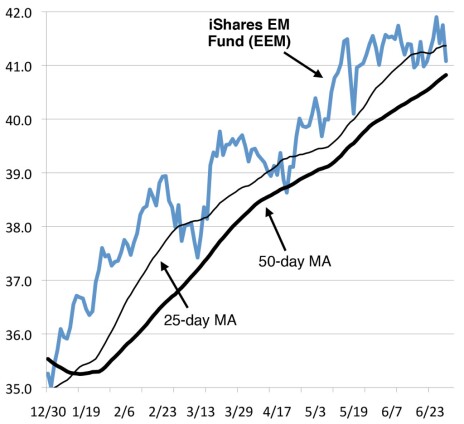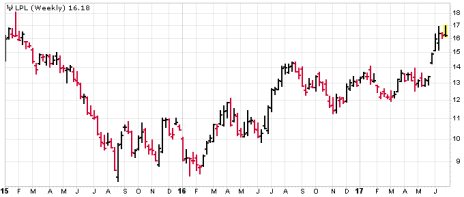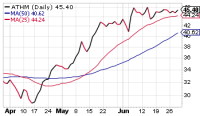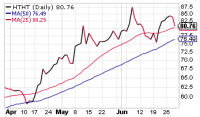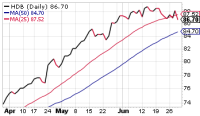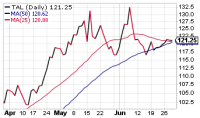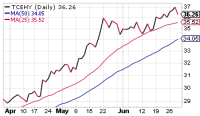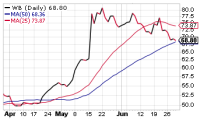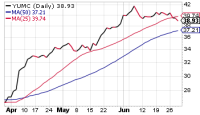While the Cabot Emerging Markets Timer remains technically positive, there’s no doubt that all EM stocks, including many of our own holdings, have been under pressure in recent weeks. We’re taking steps today to lower our exposure by trimming a couple of stocks, but we also have a strong Korean stock to add to the portfolio.
Cabot Emerging Markets Investor 636
[premium_html_toc post_id="135699"]
Cabot Emerging Markets Timer
The Emerging Markets Timer is our disciplined method for staying on the right side of the emerging markets. The Timer is bullish when the index is above the lower of its two moving averages and that moving average is trending up.
It’s been a choppy environment since mid-May, but our Emerging Markets Timer continues to tell us the intermediate-term trend is up. The iShares EM Fund (EEM) hit 41.5 in mid-May (adjusted for recent dividend payments) and isn’t far removed from that level today, despite a couple of sharp dips and rallies. But EEM has always held above its lower (50-day) moving average, keeping the trend positive.
Thus, we remain mostly bullish, though it’s important to take things on a stock-by-stock basis—you should sell any stocks that crack, but also hold on tightly to your strong, resilient stocks.
How Much News
Investors need to keep up with what’s happening in the world, that much is clear. While it’s certainly possible to manage a portfolio by just watching the charts of your holdings, if you don’t know the stories behind the action of your stocks, you could wind up behind the moves to either the upside or the downside.
But with every website on a 24-hour news cycle, you could spend every minute of every day trying to keep up, even if you screen out the click bait, “sponsored” stories and partisan sensationalism.
Right now, the market is taking a step back from the growth stocks that have been the favorites of investors since the start of the year. So it’s worth your time to pay extra attention to stories that may explain what’s happening and what’s likely to happen.
The biggest news from the White House visit of India’s Prime Minister Narendra Modi was probably the hug that the outgoing Modi shared with President Trump. Beyond that video moment, not much of substance is expected from the meeting, despite the issues that need addressing.
High on the list that Modi might like to raise would be the U.S. administration’s announced policy of seeking tariff protection on imports from other countries to protect U.S. industries. India has a trading surplus with the U.S. that averaged over $2 billion a month in 2016 and is at $7.45 billion through the first four months of 2017.
That’s fairly small potatoes compared with the Chinese trade figures—a $347 billion U.S. trade deficit in 2016 and a $106.5 billion imbalance through the first four months of 2017—but the principle is the same. The President seems to take these imbalances as a prima facie case for tariff protection.
In the past, the U.S. government has imposed tariffs primarily in response to specific charges of dumping—selling below cost to gain market share, reduce excess inventory or to suppress competition. That’s what happened when the U.S. imposed heavy duties on steel imports from China and six other countries in 2016.
But tariffs are a two-way street, and there is always a danger that any imposition of protective or retaliatory duties will be met with reciprocal actions from affected countries. That kind of escalating protectionist policy can quickly degenerate into a trade war.
There is one famous U.S. manufacturer who’s trying to negotiate one of India’s strict tariff barriers, the duties on the importation of passenger cars. Elon Musk, the CEO of Tesla Motors, has his eye on the Indian market—the fourth largest auto market in the world—as a vital step in his marketing plan. But India imposes a total effective duty of up to 120% (!) on new, unregistered cars, which is an effective ban on sales for all but the most determined buyers.
Musk is in negotiations with the Indian government for relief from import penalties, arguing that Teslas will help to meet the country’s emission-reduction goals. But that’s just a temporary solution, as Musk’s longer-term goal is to follow the lead of other automotive companies (Harley-Davidson included) by building a factory in India.
The new factory will cost a bundle, of course, as will building a charging network like the ones Tesla has rolled out in North America, Europe and China. The Indian government has said that it wants to have six to seven million electric and hybrid vehicles on Indian roads by 2020, so the wind might just be blowing in Tesla’s direction right now.
Our decision two weeks ago to put an Indian financial stock, HDFC Bank (HDB), in the portfolio was partly in response to the excellent performance of Indian stocks since the start of 2017, and partly because markets appear to be getting tired of growth stocks, with financials attracting some of that money.
That’s the kind of news that can reward you for paying attention. And, as always, we’ll be watching the headlines on your behalf.
Featured Stock
Bright and Sharp
LG Display (LPL)
Emerging market stocks, including the Chinese stocks that are the core of our portfolio, have been trading sideways since the middle of May. Our stocks are holding up pretty well, but “holding up pretty well” isn’t the mandate of Cabot Emerging Markets Investor.
Accordingly, because we consider our investment universe to include the whole world outside the U.S., we are casting our net a little wider. Our stock pick today is a Korean company, LG Display (LPL), that makes displays for TVs, computers, tablets, pads, mobile phones, automobiles and anything else that needs a screen. Originally a joint venture between Korea’s giant LG Electronics and the Dutch company Koninklijke Philips Electronics, LG Display became independent in 2004 and changed its name to LG Display in 2008, when Philips sold its stake. The company began developing thin film transistor liquid crystal displays (TFT-LCDs) in 1985 and began mass production in 1995.
One historical note: The company got a black eye in 2008 when the U.S. fined it (and other manufacturers) for LCD price fixing, a charge that led to a big fine from the EU in 2010. There haven’t been any repeats of that kind of activity and the event is long forgotten from investors’ minds.
LG Display is the biggest maker of LCD panels and one of the biggest makers of TFT-LCD screens, organic light-emitting diode (OLED) screens and flexible display screens in the world. It’s a big company, with a market cap of almost $12 billion and annual sales of $24 billion. About 38% of revenue comes from TV screens, 16% from computer monitors, 9% each from tablet and notebook computer screens and the rest from mobile phone screens and other displays such as medical devices and GPSs. LG is a major supplier for panels used by Dell, NEC, ASUS and Apple, including iMacs, iPads, iPhones and iPods.
Like many tech sector business lines, displays are cyclical commodities, although LG Display’s continuing development of flexible screens and hyper-resolution displays gives it some protection from commoditization. Revenue was essentially flat for the four years from 2013 through 2016, but LG’s Q1 earnings report on April 26 was a blockbuster, with revenue up 21% and earnings up a huge 8,400%, coming in well above expectations.
LPL hit a rough patch in 2015, falling from 18 in January to 8 in August. The stock revisited that low at 8 in January 2016 and again in February. But the stock advanced to 12 in April and 14 in August, followed by a nine-month consolidation in a tightening trading range. The stock broke out in late May on heavy volume thanks to the Q1 earnings report, and roared to 17 on June 13 on its heaviest trading volume since August 2015.
The stock has been trading sideways since that June 13 top, slipping to 16, then making another run at 17. At this price, the stock is trading at a P/E below 9, which, combined with its forward annual dividend yield of 1.3%, makes it quite a bargain.
LPL isn’t likely to be a runaway winner, but the cyclical display industry is in an uptrend, and the company has a strong position in its market and good barriers to entry. We regard it as a low-risk defensive pick, but its late-May/early June rally has shown that it can move quickly too. LG Display will be reporting Q2 results on July 25, and analysts are forecasting earnings of 64 cents per share and revenue of $6.29 billion. You can buy right here or wait for another small dip toward 16. BUY A HALF.
LG Display (LPL 16)
LG Twin Towers
128 Yeoui-daero
Seoul 07336
South Korea
www.lgdisplay.com
Model Portfolio
Invested 85% Cash 15%
Updates
It’s been a wild ride since mid-May, with a few significant retreats among growth and emerging market stocks, with some equally sharp rebounds. This volatility after a big run can occasionally be a yellow flag (telling you the bulls and bears are fighting it out, a sign of distribution).
But when things get wild, it’s important not to be too smart. Instead, just follow the system, which remains positive for the emerging markets sector as a whole. That means we’re taking things on a stock-by-stock basis, ditching those that are showing too much wear and tear, but remaining patient with those that are holding up well.
On that note, we’re going to sell half our shares in JD.com (JD), which is acting funky after a long run, and sell our half position in Weibo (WB), which hasn’t been able to stabilize after last week’s run-in with the Chinese government.
Alibaba (BABA) took a hit today, but continues to act about as well as can be expected given the market’s wobbles in recent weeks. Analysts are optimistic the firm’s e-commerce growth has a long way to run, and that the company’s data efforts (based on customers’ buying habits) will prove valuable to major brands that want to target their marketing more effectively. Hold on if you own some, and if you don’t, you can buy a little here. BUY.
Autohome (ATHM) looks great, as it calmly consolidated in the 43.5 to 46.5 area for most of the month. If the market caves in, ATHM is likely to follow it, but the stock’s resilience thus far tells you big investors aren’t eager to let go of their positions. We’ll stay on Buy, though if you buy around here you should probably start with a smaller-than-normal position. BUY.
China Lodging Group (HTHT) seemingly has nine lives, as the stock’s sharp selloff toward its 50-day line earlier this month was met with five days in a row of big-volume buying before today’s drop. The company will likely announce second-quarter metrics within a couple of weeks, which could move the stock. Given the recent action, though, we’ll stick with our Buy rating. BUY.
HDFC Bank (HDB) had a nice, persistent advance in April and May, and in June, it’s basically gone straight sideways. With the 50-day line above 84, some further weakness is possible, but we continue to think HDB is a good buy around here. BUY.
JD.com (JD) hasn’t done anything wrong, per se, but its action has turned very sloppy after a big run, with the stock moving from 44 to 37, back to 44 and then just below 40 yesterday. Fundamentally, business remains solid—the firm’s anniversary event (June 1 through June 18) resulted in $17.6 billion worth of transactions, up 50% from the same period a year ago. That said, JD has been running higher since the start of the year without much of a pullback, so the recent up-and-down action is a worry. Thus, tonight, we’re going to sell half our shares in JD, booking a solid profit, and use a mental stop in the 36 area for our remaining position. SELL HALF, HOLD THE REST.
Melco Resorts (MLCO) has eased over the past few days but the damage has thus far been limited; the downturn has come on light volume, the stock is less than two points from its recent highs and it’s sitting right around its 50-day line. Be aware that the latest Macau numbers (for June) should be released next week, which will push or pull the stock. We’re OK with a Buy rating given the stock’s resilience, but keep any new position on the small side. BUY.
TAL Education (TAL) is holding near its 50-day line, so we’re content to hold our remaining half position. That said, a break of 110 or so would probably have us taking the rest of our solid profit and moving on. HOLD A HALF.
Tencent Holdings (TCEHY) looks terrific—the stock actually pushed out to a new high this week (one of the few growth stocks to do so) before pulling back a bit today. The stock’s had a good-sized run since the start of the year, but, clearly, sellers aren’t active here. Fundamentally, there’s growing excitement about one of the firm’s mobile games (Brawl Stars, published by Finnish gaming firm Supercell, which Tencent bought last year), which is scheduled to be released soon and could be a hit. If you don’t own any, you can buy some around here or on dips of a point or so. BUY.
Weibo (WB) has been skidding since the Chinese government’s regulatory action that we wrote about in last week’s update. The stock made some attempt to hold its 50-day line, but today’s big market selloff threw that hope to the side. We don’t think WB is likely to crash, but the fact is that, unlike most stocks that broke out in April or May, this one has been fading since its big earnings gap many weeks ago. We’re going to sell our half position and hold the cash. SELL.
Yum China (YUMC) looks fine to us, pulling back normally since early June after its solid run in April and May. The next big event will be next Wednesday, when the company will report quarterly results; analysts are looking for about $1.6 billion in revenue and earnings of 27 cents per share (up 35% from a year ago). Big picture, we think the stock’s post-IPO breakout in April was probably the start of a longer-term upmove, but we’ll see how YUMC reacts to earnings next week. You could buy a little on this retreat. BUY A HALF.
[premium_html_footer]
Send questions or comments to paul@cabotwealth.com.
Cabot Emerging Markets Investor • 176 North Street, Salem, MA 01970 • www.cabotwealth.com
All Cabot Emerging Markets Investor buy and sell recommendations are made in issues or updates and posted on the Cabot subscribers’ website. Sell recommendations may also be sent to subscribers as special alerts via email. To calculate the performance of the hypothetical portfolio, Cabot “buys” and “sells” at the midpoint of the high and low prices of the stock on the day following the recommendation. Cabot’s policy is to sell any stock that shows a loss of 20% in a bull market (15% in a bear market) from our original buy price, calculated using the current closing (not intra-day) price. Subscribers should apply loss limits based on their own personal purchase prices.
THE NEXT CABOT EMERGING MARKETS INVESTOR IS SCHEDULED FOR JULY 13, 2017
We appreciate your feedback on this issue. Follow the link below to complete our subscriber satisfaction survey: Go to: www.surveymonkey.com/chinasurvey
Cabot Emerging Markets Investor is published by Cabot Wealth Network, an independent publisher of investment advice since 1970. Neither Cabot Wealth Network, nor our employees, are compensated in any way by the companies whose stocks we recommend. Sources of information are believed to be reliable, but they are in no way guaranteed to be complete or without error. Recommendations, opinions or suggestions are given with the understanding that subscribers acting on information assume all risks involved. © Cabot Wealth Network 2017. Copying and/or electronic transmission of this report is a violation of the copyright law. For the protection of our subscribers, if copyright laws are violated, the subscription will be terminated. To subscribe or for information on our privacy policy, visit www.cabotwealth.com, write to support@cabotwealth.com or call 978-745-5532.
[/premium_html_footer]

